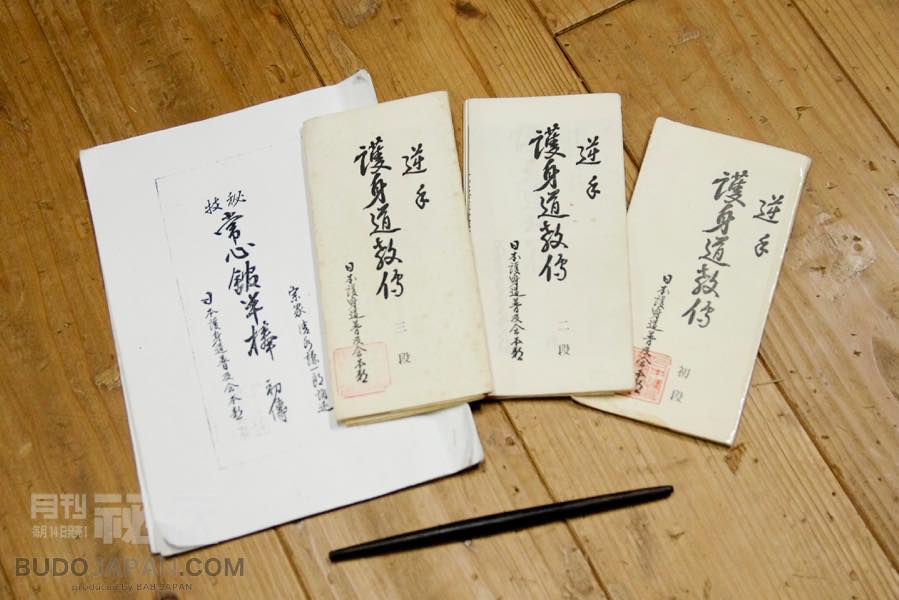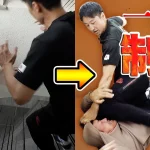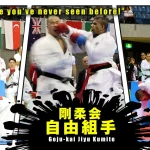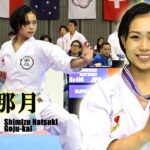Gyakute Goshindô 1 The essence of the old-fashioned jûjutsu technique
text by Satoshi Taito, translation by Lionel Lebigot
Once you get the hang of it, anyone can use it!
Nihon Goshindô” was founded in the post-war period by Shimizu Ken’ichirô. The self-defence techniques were taught as correspondence courses and had many students throughout the country. The content of the book, which incorporates many of the teachings of the old schools, is truly suitable as a self-defence technique. It is also an excellent learning experience for practitioners of other martial arts styles. In these times of crime, it is precisely because we are in the era of peace and harmony that we are witnessing the emergence of “Gyakute Goshindô”. In this book, we will introduce you to a number of Gyakute Dôjutsu techniques, which anyone can use once they get the hang of it. Former police inspector of the investigation department and the forensic science division, kobujutsu master Yoshifumi Hayasaka will guide you through the Gyakute Goshindô techniques.
The decline of martial arts and the development of self-defence.
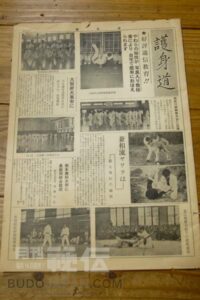
Bulletin of the “Nihon goshindô kyôkai”, published in 1976. It contains a four-page report on activities, feedback from members and information on initiation, correspondence and workshops.
Goshinjutsu developed from the end of the Edo period to the beginning of the Shôwa period. During the new Meiji era (1868-1912), the role of the bushi declined sharply. However, the practice of their fighting techniques continued and survived in various forms, more adapted to the spirit of the times. It was during the Meiji and Taishô periods that budô developed, particularly in rural areas. The Dai Nihon Butokukai was then formed, and the propagation of kenjutsu became kendô and jûjutsu became jûdô. It was also at this time that jûdô and kendô, budô (modern, therefore), were created by converting the techniques of koryû (jutsu) into a modern system. Kôdôkan jûdô, created by Jigoro Kano, was popularized throughout the country under the banner of vigor and good use of energy, thus laying the foundations of budô. The Teikoku Shôbukai, founded by Noguchi Seihachirô and Noguchi Kiyoshi (Seiryûken), compiled a number of bujutsu, including jû-jutsu, into instructional manuals and disseminated them throughout the country by means of correspondence courses.
As this budo practice flourished, self-defense techniques to protect against emergency attacks were developed and popularized. A pioneering book on goshindô was published in 1917 by Tsunatarô Oda and Kanzane Satô, entitled “Women’s Training Methods and Self-defense Techniques”. Many other self-defense books were published afterwards, such as “Joshi Gohô”, “Seinen Gohô Jutsu” and “Gohô Jutsu Hiden”, as goshindô was booming. While bujutsu had experienced a decline in interest after the war, Shimizu Ken’ichirô sensei’s “goshindô” succeeded in bringing together various schools of bujutsu and introducing a system of correspondence courses to popularize the art.
From bujutsu to goshindô.
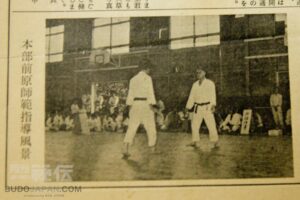
Maehara sensei conducting a teaching session at the honbu-dôjô.
Concerned about the decline of traditional Japanese martial arts after the war, Shimizu Shihan, in consultation with Mochizuki Sho’ichirô, with whom he had been in contact, created the “日本護身道普及協会/Japanese Association for the Promotion of Goshindô”. Shimizu Shihan studied mainly Kenshô-ryû jû-jutsu, which he had learned from Takeishi Kenshô, as well as Hakkô-ryû jû-jutsu, of which Mochizuki Shihan had received the menkyo-kaiden/complete transmission, and kyôdensho/instructional rolls from the Imperial Shôbukai, and added them to the “goshindô” system. Goshidô was then transmitted and disseminated by Maehara Seizô shihan, who took charge of the Nippon Goshindô Fukyûkai/association for the Promotion of Goshindô.
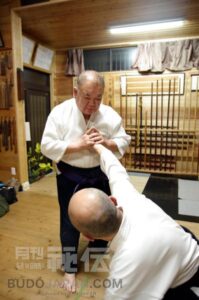 In 1952, the first edition of the Gyakute Goshindô Kyôden was published and a correspondence course system was introduced to promote the dissemination of the art. Five volumes of the kyôdensho were published, from Shodan to Godan, and self-defence techniques using sticks and umbrellas were also taught in the form of Jôshinkan Hanbô. Hayasaka Yoshifumi shihqn, who presides over the Nittô Bujutsu Kenkyukai Jôshinkan, gives a demonstration and commentary on the content and techniques of the Gyakute Goshindô Kyôden Shodan.
In 1952, the first edition of the Gyakute Goshindô Kyôden was published and a correspondence course system was introduced to promote the dissemination of the art. Five volumes of the kyôdensho were published, from Shodan to Godan, and self-defence techniques using sticks and umbrellas were also taught in the form of Jôshinkan Hanbô. Hayasaka Yoshifumi shihqn, who presides over the Nittô Bujutsu Kenkyukai Jôshinkan, gives a demonstration and commentary on the content and techniques of the Gyakute Goshindô Kyôden Shodan.
Shimizu shihan, the founder of self-defence, was a high-ranking police officer in the Metropolitan Police Department, including as chief of police, during the Meiji, Taisho and Showa periods. As a police officer, the art of self-defence must have been an indispensable skill, and it is believed that he felt the need for goshindô first hand. Hayasaka shihan, who was also active as a senior police officer in the Metropolitan Police Department, inherited the self-defence techniques of the Shôwa era, which he teaches today in connection with bujutsu.
Gyakute Goshindô: Shodan
The Gyakute Goshindô Kyôden Shodan contains a history of the origins of jû-jutsu and notes, followed by etiquette and a number of self-defence techniques. The notes begin with hygiene precautions, such as keeping fingernails short, and warn against the use of force, stating that “practice should not be done with force” and that “attempting to use force to perform a technique or challenge force is not only dangerous but also prevents rapid progress in the technique”. This shows the confidence in the reasoning behind the goshindo techniques, which allow women and children to compete with adult men without resorting to force.
The techniques are illustrated with examples of various situations of aggression by thugs and the techniques for dealing with them are explained with photographs and descriptive text.
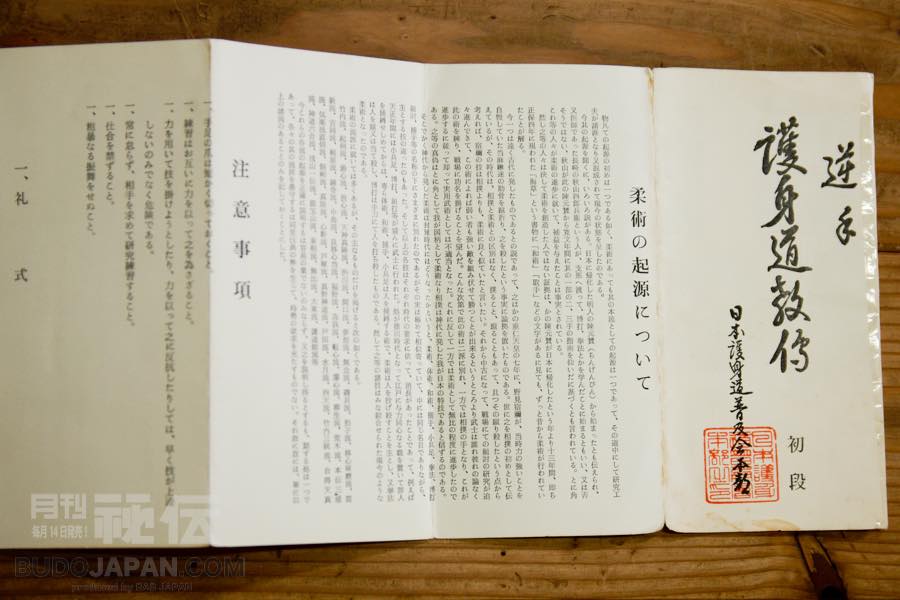
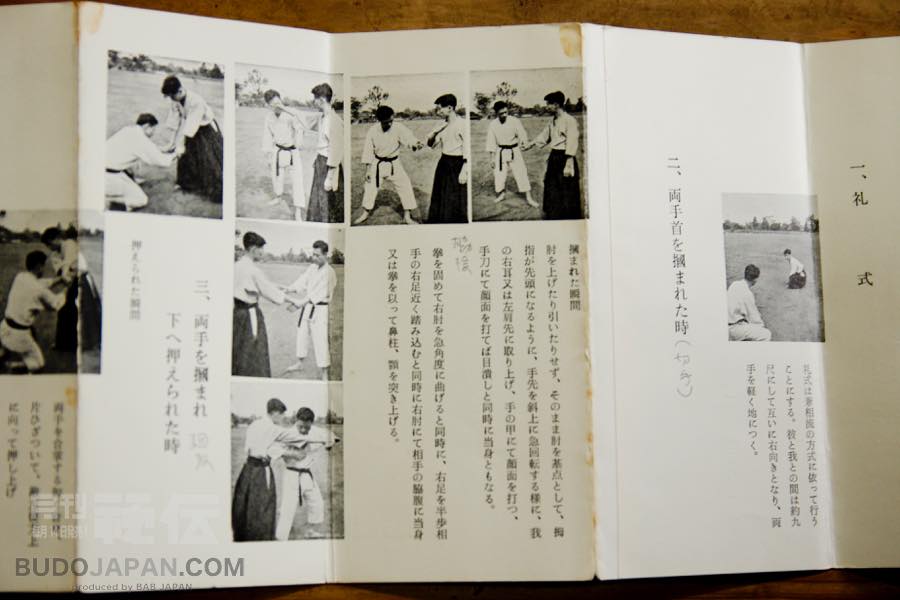
Copy of the Shodan Kyôdensho of Gyakute Gōhōdō. Techniques are illustrated with a series of photographs and specific descriptions.
The technique of releasing the seized hands and counterattacking is presented as a self-defence technique for “when both wrists are seized”. It is thought to be the teodoki technique practiced in Tenjin Mayo-ryu and other Yoshin-ryu jû-jutsu. The jû-jutsu of the imperial Shôbu-kai, which was incorporated into the goshindô techniques. The techniques of goshindô, come from among others, those of the Tenshin Shinyô-ryû and the tehodoki.
When an opponent captures your right hand with his left hand. Step back one step and turn your hand horizontally to release the captured hand, then put it back into the opponent’s hand to sweep the eyes. To perform the hand release technique, from the captured wrist, open the palm wide, raise the elbow towards the right ear or left shoulder with the fingers forward, and pull the side of the thumb between the opponent’s thumb and forefinger. When the caught wrist is released, immediately turn your wrist back and with a sharp jerk, rub his eyes. Shooting into the space between the fingers is important, and Hayasaka Shihan explains, “That’s why we call this technique kitte (cutting the hand).
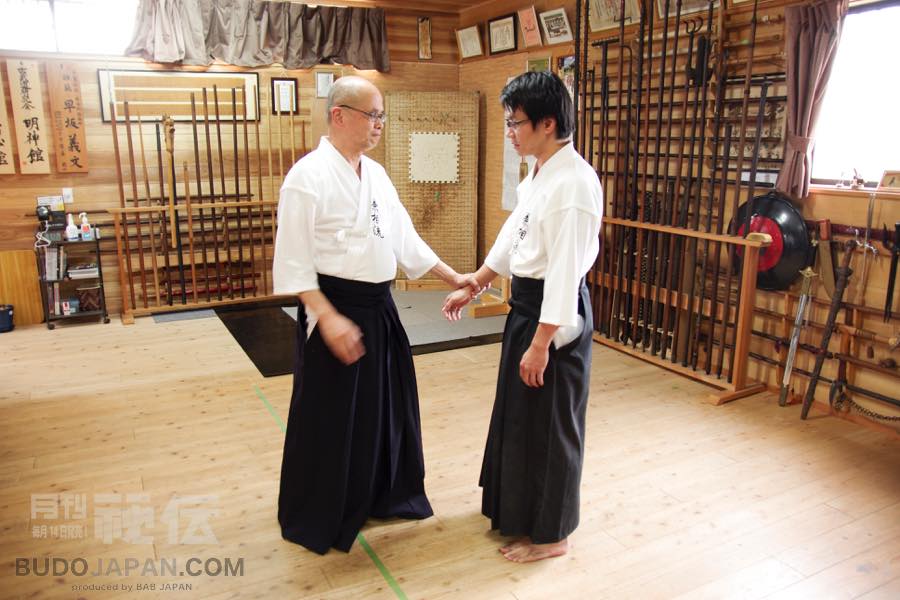
When an opponent captures your right hand with his left hand.
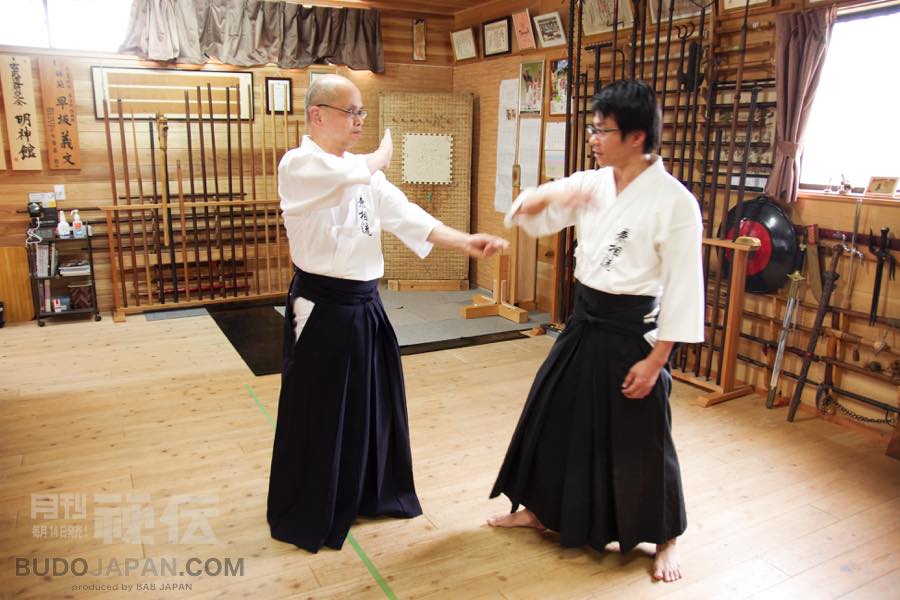
Take a step back and turn your hand horizontally to release the captured hand,
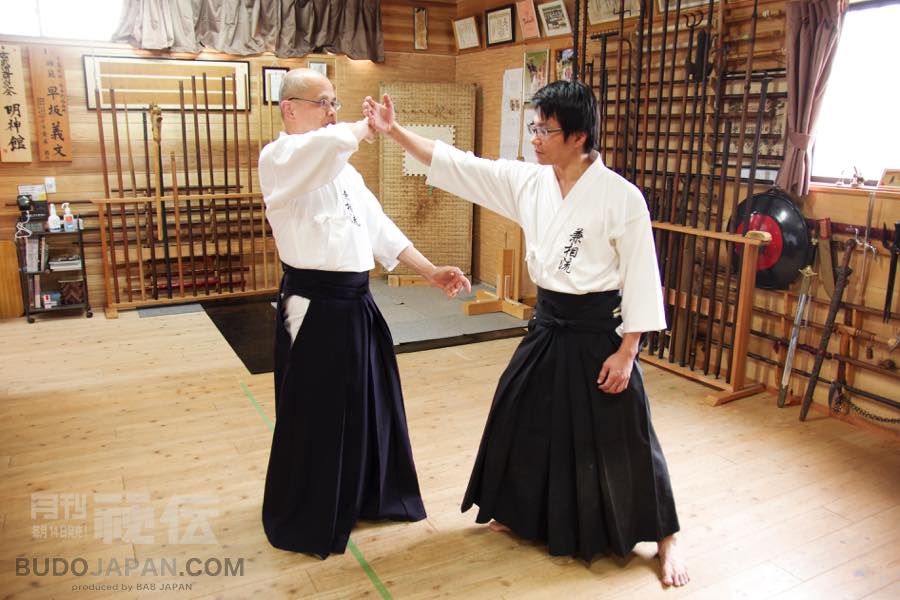
then attack its eyes.
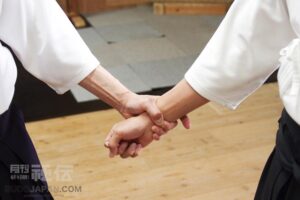
In the case of a wrist grab, open the palm
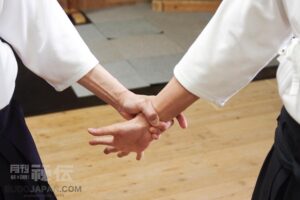
wide, raise the palm
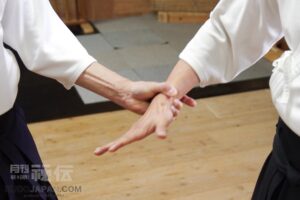
elbow toward the right ear or the point of the left shoulder,
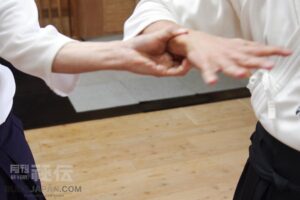
and pull the side of the thumb between the opponent’s thumb and index finger.
In the technique demonstrated, when releasing a grabbed hand with the left hand, the right foot goes behind the opponent without pulling the foot back, and the returning hand turns into a technique to break the opponent’s throat and knock him backwards.
The te-hodoki (arm extension) technique makes it easy to defeat an opponent without using much force. By using this simple technique, women and children can defeat an adult. It is an excellent first technique for the study of goshindô.
In the applied technique
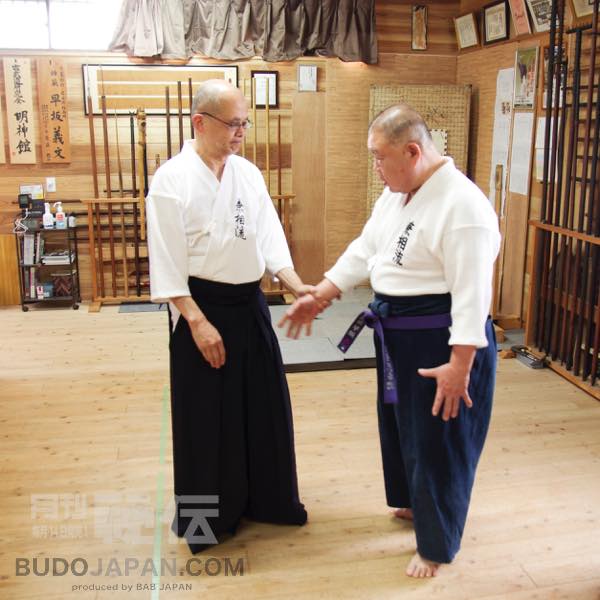
when untying a grabbed hand with the left hand
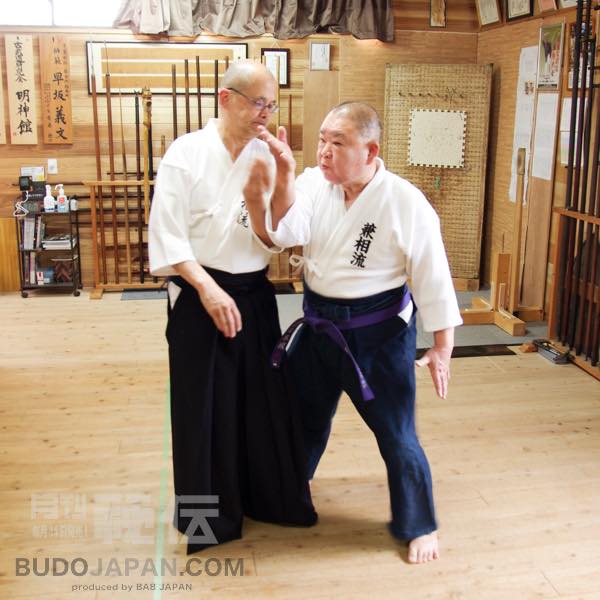
stand behind the opponent
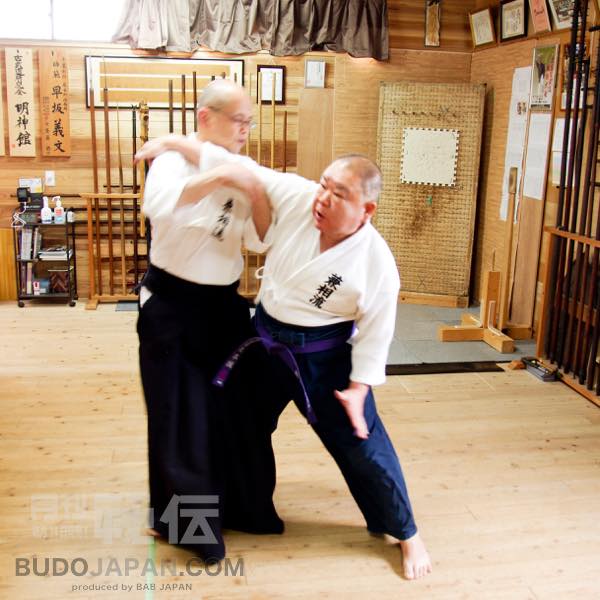
causing him to fall backwards.

causing him to fall backwards.
When both hands are grabbed, clench the fists, raise the left elbow to throw the opponent off balance, bend the right elbow at a sharp angle and release his hands. While taking a step forward with the right foot, strike an elbow to the vital point under the armpit (armpit yin). You can also make other strikes with your fist on the chin or nose. By bringing the left elbow up, you open the opponent’s right armpit, and by pushing the tip of the elbow in, you stop the breath. Elbow strikes on vital points are quite devastating.
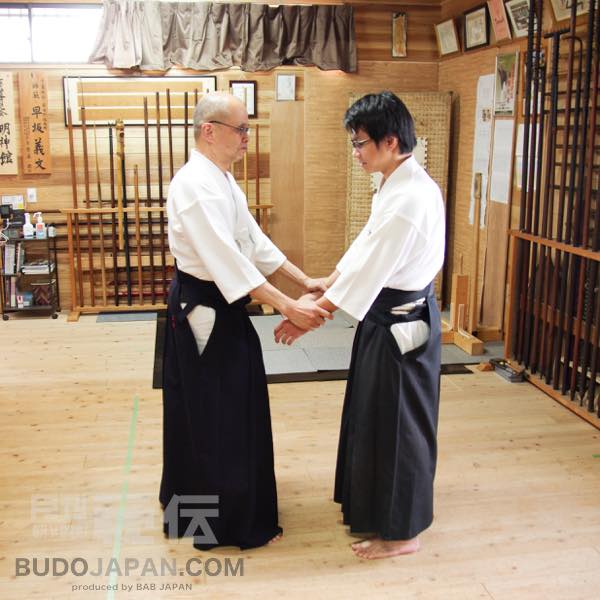
When both hands are grabbed,
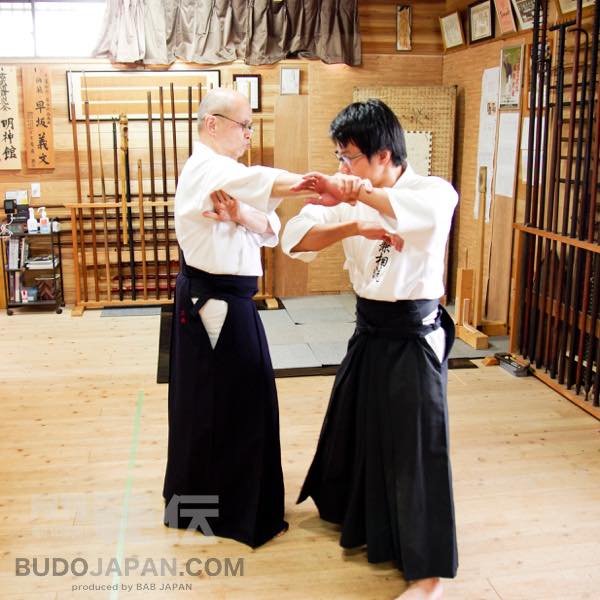
Bring the left elbow up to throw the opponent off balance, bend the right elbow.
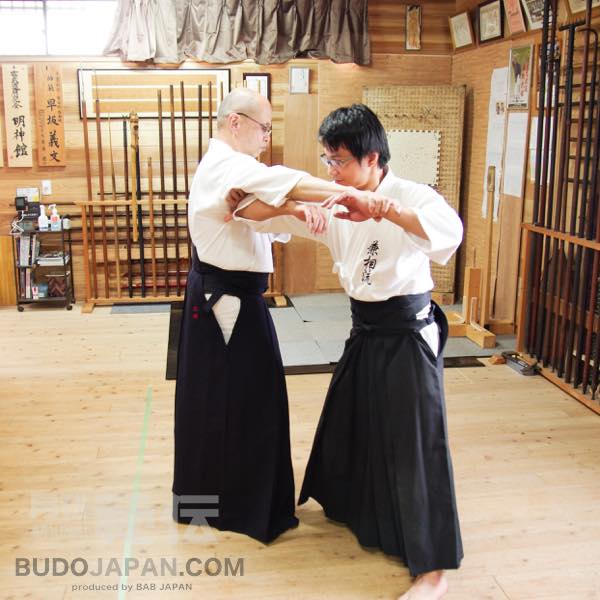
Step forward with the right foot and strike with the elbow into the armpit.
This technique also has many applications, such as attacking the face with elbows and fists, as well as throwing the arm back after an elbow strike.
The kyodensho techniques are only shown on one side, but if you practice a technique with your right hand, try to practice it with your left hand as well. Hayasaka shihan explained the importance of application and ingenuity in practice.
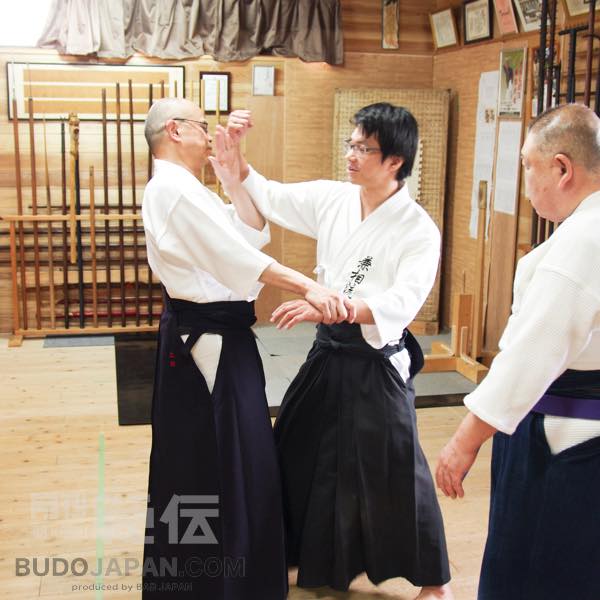
After the te-hodoki, the technique can be applied and modified into
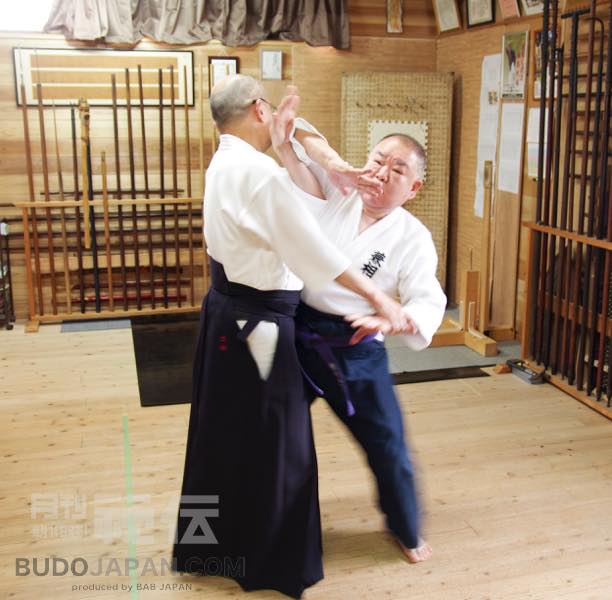
fist and elbow attacks to the face
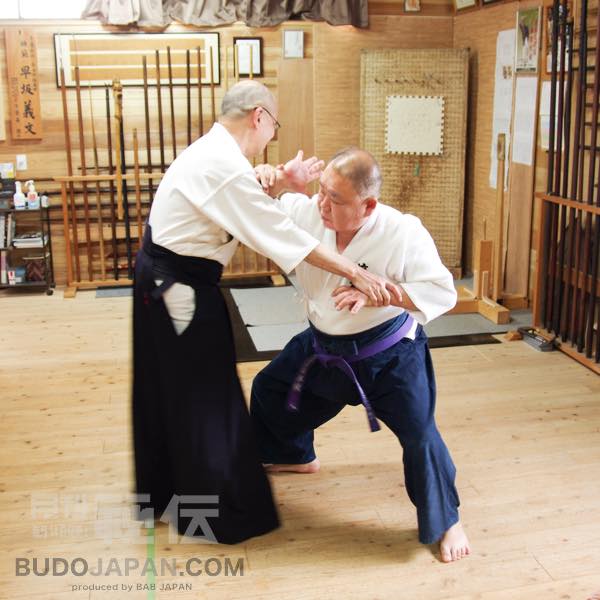
elbow strikes to the epigastrium.
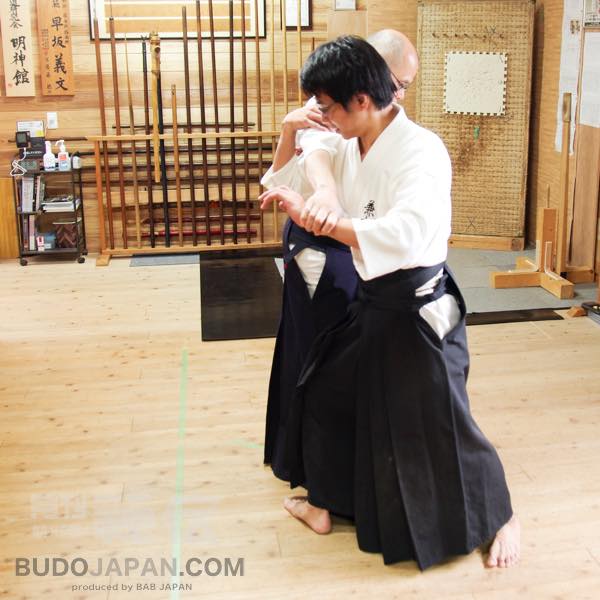
After a elbow strike,
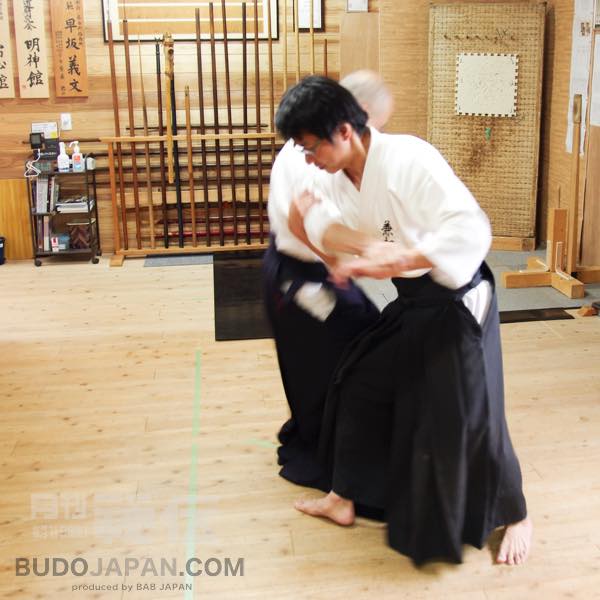
the arm can be whipped
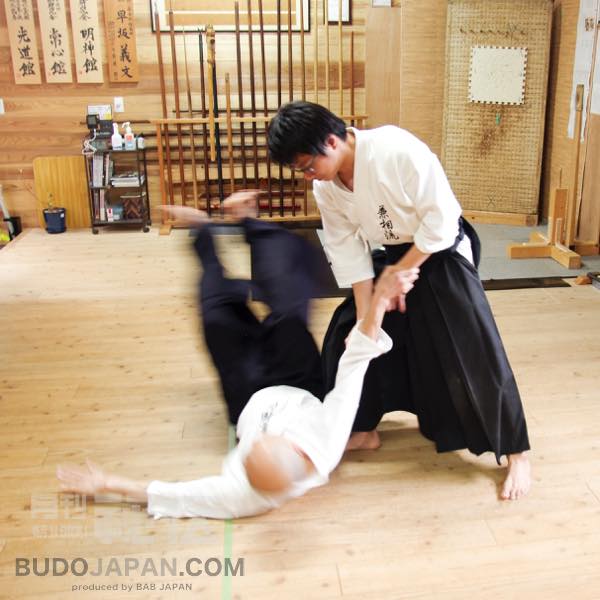
and thrown back.
In “When the opponent grabs my left hand and hits me in the face with his left fist”, the pictures illustrate counter techniques. Receive the punch that hits you by holding the opponent’s left and right hands in front of you, grab the back of his right hand with your right hand, and firmly hold the opposite side of the wrist while pulling your foot back. When you receive an opponent’s strike, hold both hands in front of you to form a circle and simultaneously grasp the back of the right hand while parrying the fist. If you pull your foot back and hold the wrist, the back of the wrist will be held and you will be able to control it, just like Nikyô in Aikido.
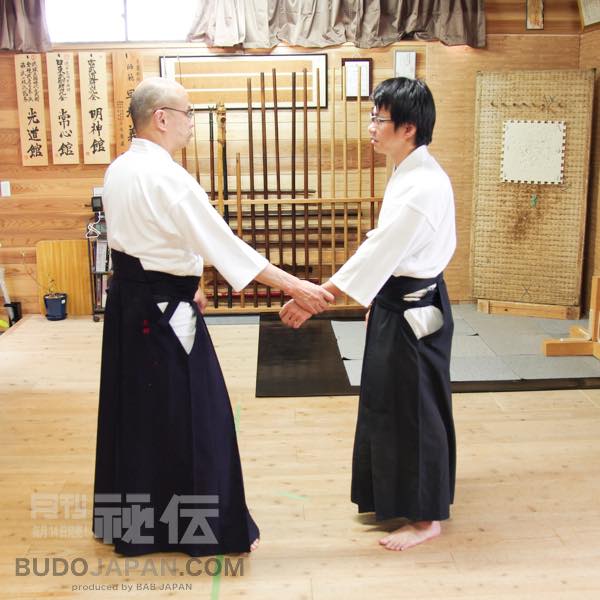
If the opponent grabs your wrists
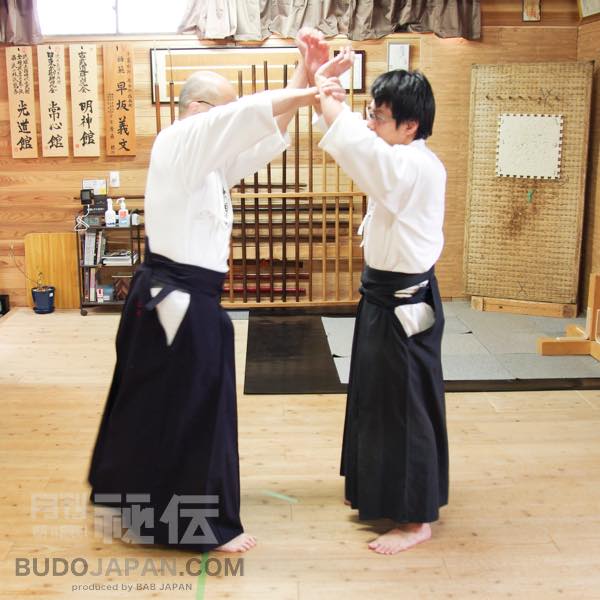
receive the punch that hits you by holding the opponent’s left and right hands in front of you
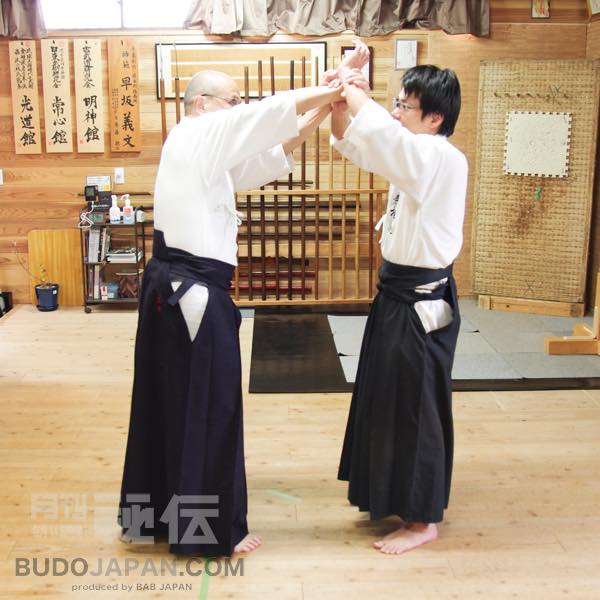
take the backhand of his right hand with your right hand
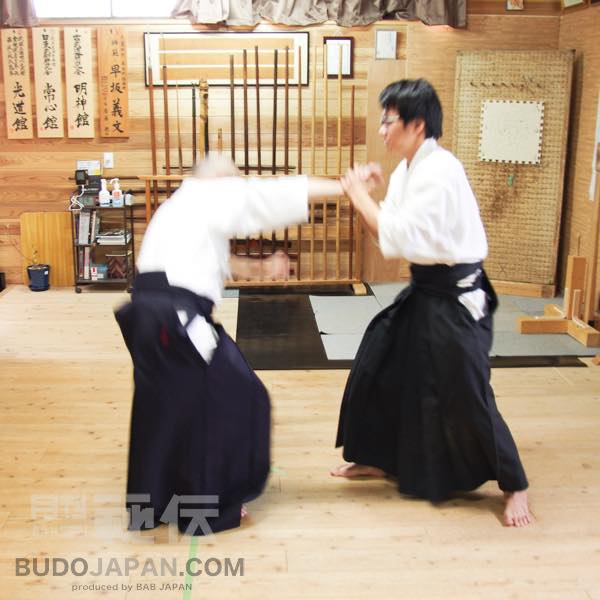
while pulling your foot back
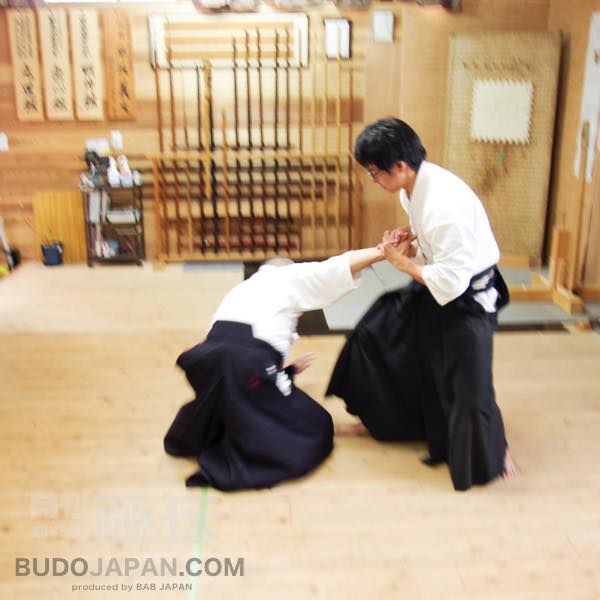
and hold the wrist.
“In the event of a front choke”, In the event of a front grab with both hands followed by a choke. While raising both shoulders and pulling the chin back to avoid the choke, grab the opponent’s right hand with the left hand, strike the opponent’s abdomen with the right hand, turn the left hand while taking a step forward on the right leg, and push the abdomen back with the right hand.
When it comes to knocking down an opponent, the technique is said to be transformed into one in which the opponent is knocked backwards by placing the palm of the hand on the xiphoid appendage and then knocking it down by striking with the palm to the chin as if knocking the opponent backwards. Similar techniques can also be seen in Tenjin Shinyô-ryû’s Kakarito and Tamega-ryû jû-jutsu’s Kihatsu, which incorporate jû-jutsu techniques of breaking posture.
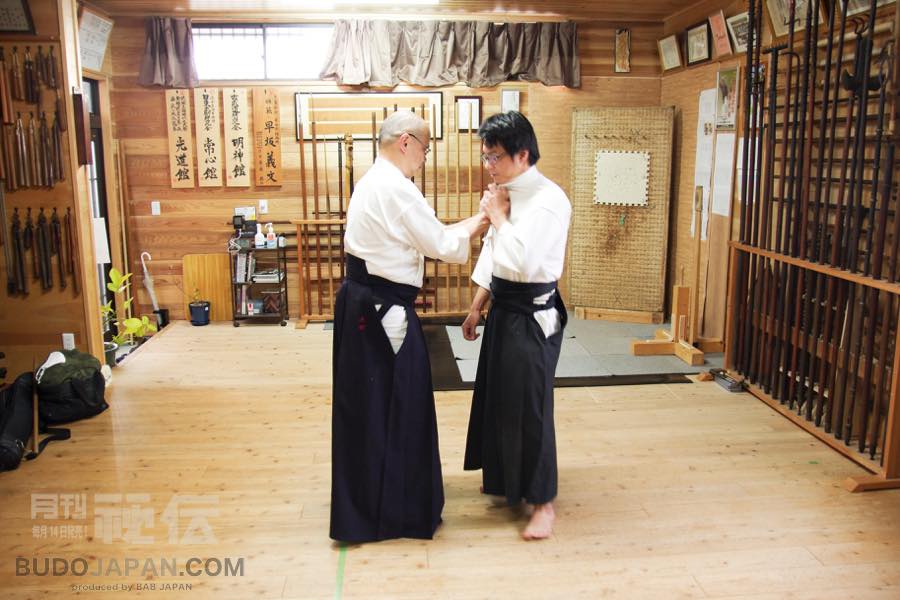
While raising both shoulders and pulling the chin back to avoid neck strangulation, grab the opponent’s right hand with your left hand,
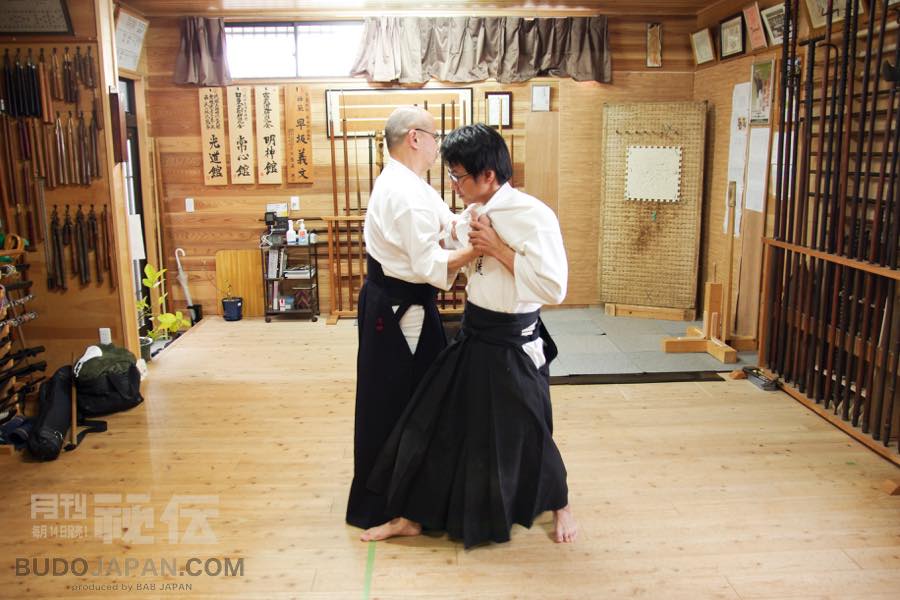
strike his abdomen with your right hand,
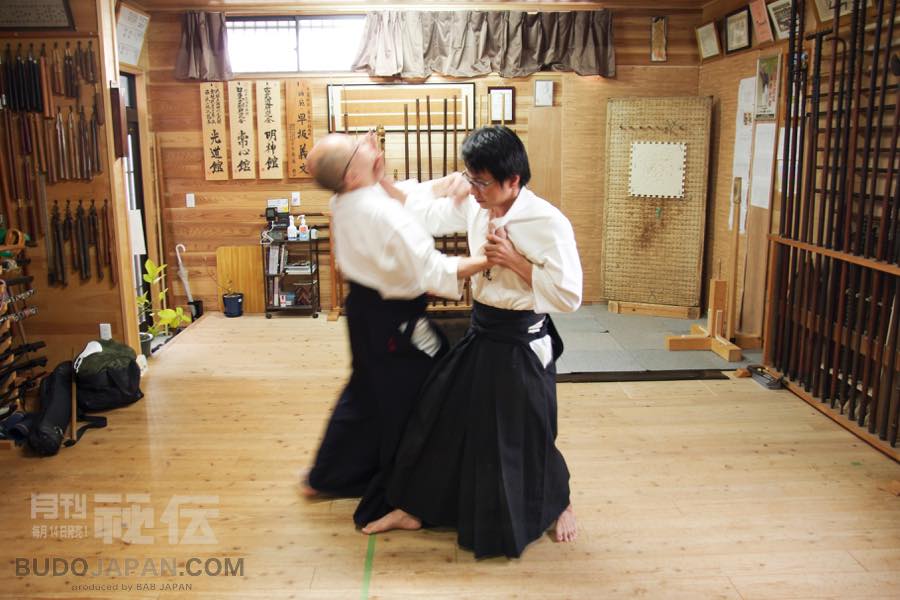
turn your left hand while taking a step forward on your right leg,
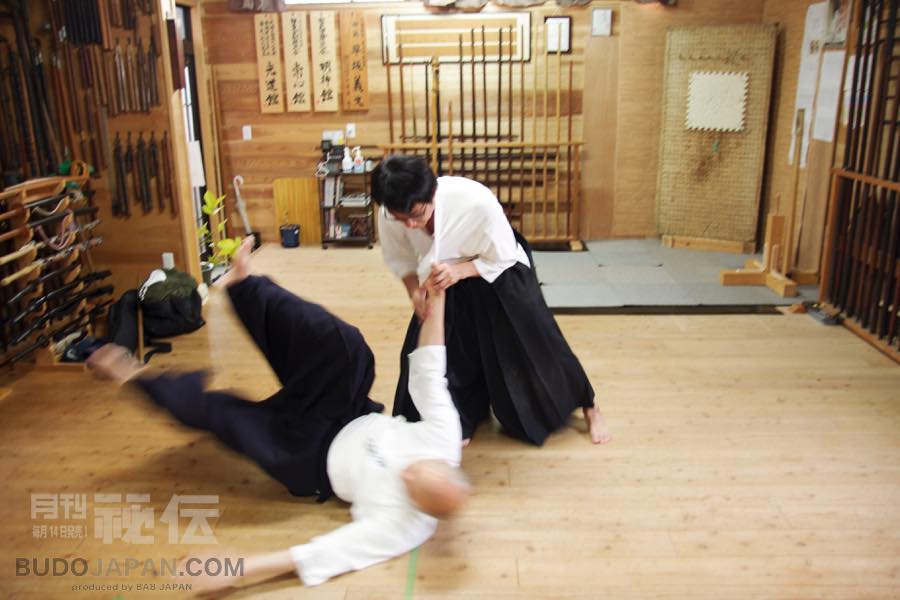
and push his chin back with your right hand.
Technique against a strike at chûdan level. A technique that can be used to control a punch, as well as when a dagger is used to stab. When the opponent hits you with his right fist, I strike his right wrist with my left shutô while moving my right foot back half a step, at the same time I hold his right fist with my right hand, place my left elbow on his right elbow and push just below, thus blocking the elbow joint.
According to Hayasaka shihan, dodging blows and strikes with the left hand shutô can also be used against knife attacks, and that the elbow can be effectively used to control movement. It is not easy to avoid an attack from an opponent armed with a blade. However, the movement of drawing back the right leg and taking a half step to parry a thrust with a left shutô is an easy technique for beginners to use. When gripping the sword hand, the opposite side of the elbow can be easily reversed, so he thinks it is a very reasonable technique.
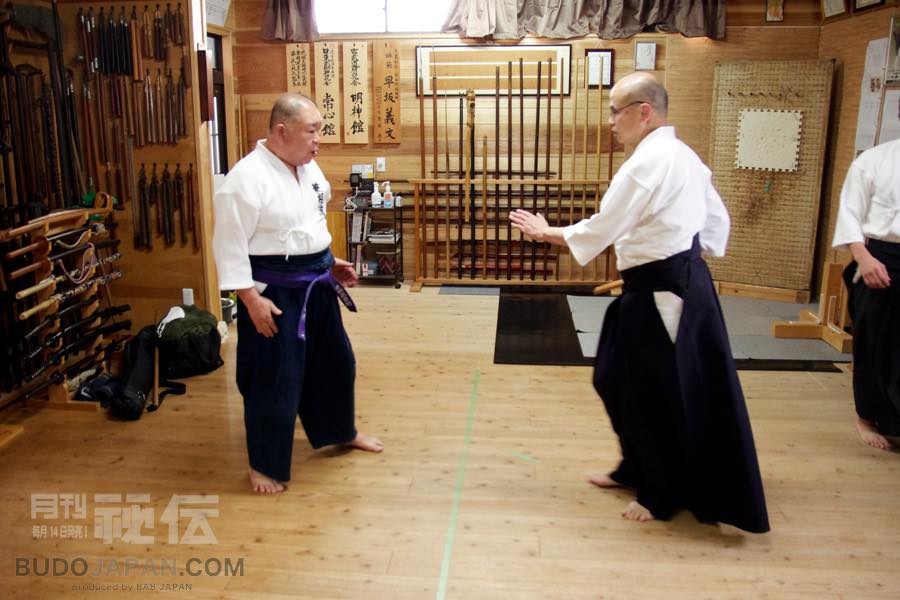
When the opponent stabs at the sternum with a knife,
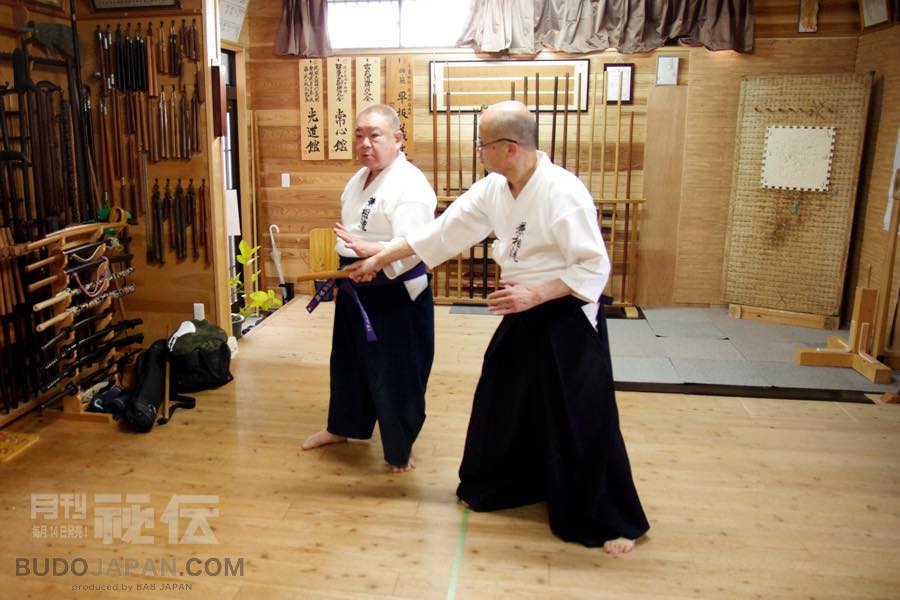
strike the opponent’s right wrist with a left shutô while stepping back half a step on my right foot,
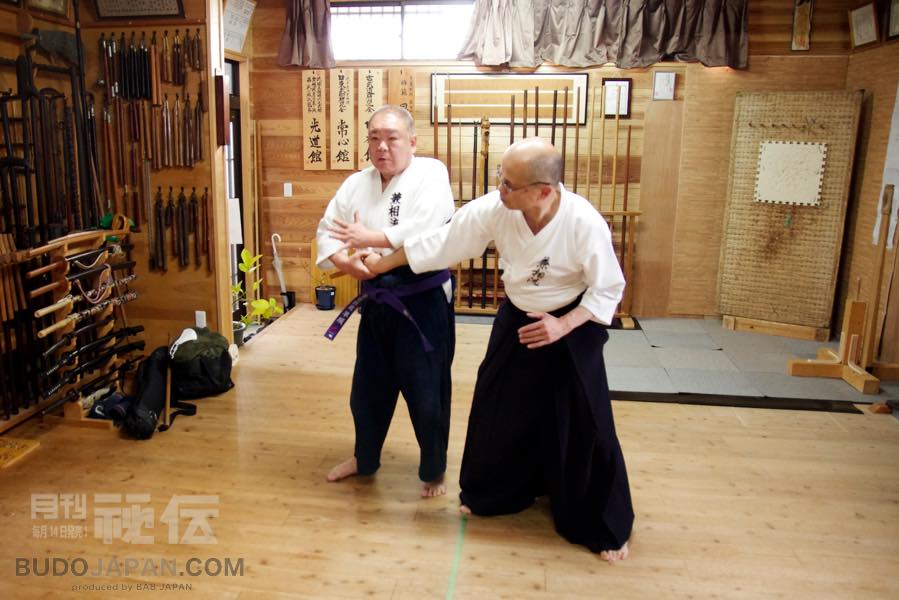
At the same time, hold the opponent’s right fist with your right hand,
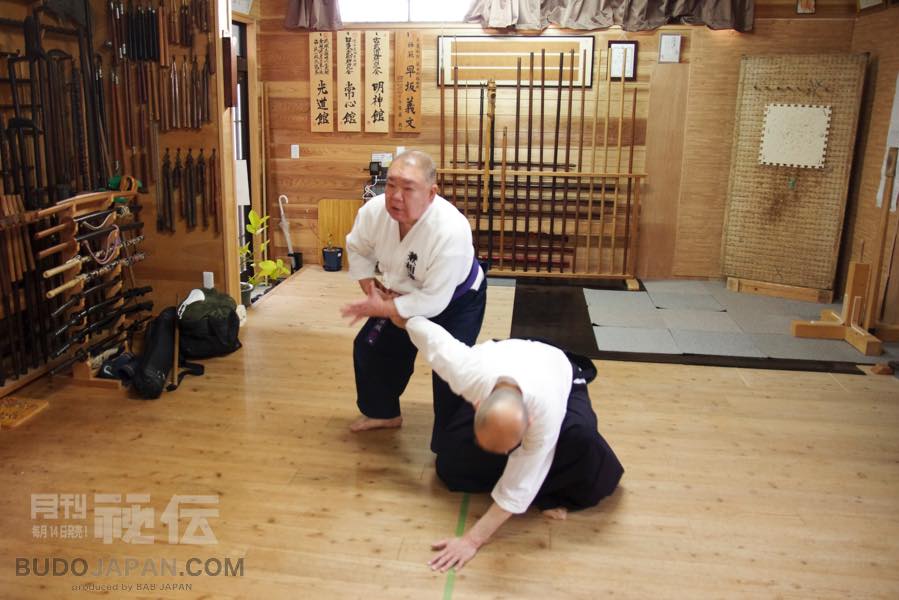
Place your left elbow on the opponent’s right elbow and push it down.
The essence of jû-jutsu techniques, demonstrated with a practical mind.
Looking at the techniques described in the kyodensho, all of them use the structure of the body to release the gripped hands with a slight force, a twist of the joints. It is important not to focus on using brute force to perform the techniques, as indicated in the kyôdensho.
The art of goshindô can be used to protect oneself regardless of size or gender, if one is able to put in the effort. This is the essence of jû-jutsu, teaching not only the art of self-defence in the heat of the moment, but also the deeper meaning of this technique as a martial art.
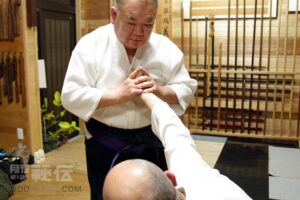
Gyakute Jûjutsu Hanbôjutsu Nihon Bujutsu Kenkyûkai Jôshinkan
Hayasaka Yoshifumi
Born in 1958 in Miyagi prefecture, Japan; studied jûdô in 1970, currently 5th dan; 1972, karate Senbukan gôjû-ryû ; 1974, Gôbukan gôjû-ryû ; 1976, Kenso-ryû jû-jutsu; 1978, Okinawa kobudô, kingai-ryû karate, Kyan Shôrin-ryû karate, Shôrinha tsuru-ken of Matayoshi Shinpô sensei. In 1997, he obtained the title of kaiden (full license). In 2013, he was appointed as the 7th generation negishi-ryû shurikenjutsu, 14th generation shirai-ryû and 16th generation Yamamoto-ryû Iaijutsu Sôke. He inherited the martial arts studied by Saitô Satoshi Sensei.
Association.
HP https://myoushinkan.wixsite.com/website
Related article: Kingai-ryû karate Okinawa kobujutsu Ryûkyû kamajutsu/kama no te/kama nu tî
Related article: Kama-jutsu of the Ryûkyû Kingdom: L’armement des fantassins né sur les champs de batailles
Related article: Traditional Okinawan performing arts, the essentials of body control Karate (tûdî) and Ryûkyû-buyô The secrets of Gamaku

